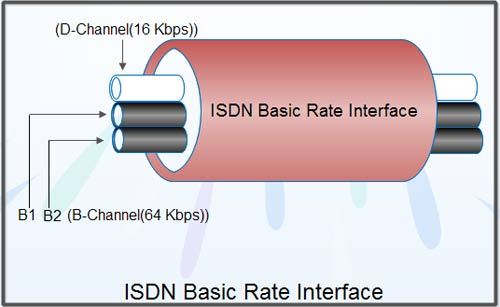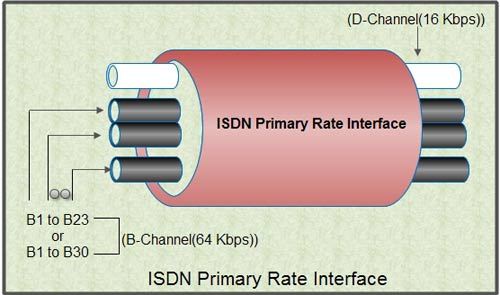ISDN provides two basic types of interfaces to users.
- Basic Rate Interface (BRI)
- Primary Rate Interface (PRI)


We’ll be covering the following topics in this tutorial:
Basic Rate Interface (BRI)
Basic Rate Interface specifies a digital pipe, consisting of two 64 Kbps B channels and one 16 Kbps D channel for a total of 144 Kbps (2B+D). Figure shows the structure of Basic Rate Interface. In addition, the BRI service itself requires 48 Kbps operating overhead. BRI therefore requires a digital pipe of 192 Kbps. Conceptually, the BRI service is like a large pipe that contains three smaller pipes, two for the B channels and one for the D channel. The remainder of the space inside the large pipe carries the overhead bits required for its operation. All 192 Kbps can be used to carry a single signal.
The BRI is designed to cater to the needs of home users and small business establishments. In most cases, there is no need to replace the existing local-loop cable. The existing twisted pair local loop can be used to carry digital transmission.
Primary Rate Interface (PRI)
Primary Rate Interface is intended for users with higher data rate requirements, such as large business establishments, offices with a digital PBX or a LAN. Because of differences in the digital-transmission hierarchies used in different countries, it was not possible to reach an agreement on a single data rate.
The United States, Canada and Japan make use of a transmission structure based on 1.544 Mbps; this corresponds to the T-1 transmission facility of AT& T. In Europe, 2.048 Mbps is the standard rate. Both of these data rates are provided as a Primary Rate Interface.
Typically, the channel structure for the 1.544 Mbps rate will be 23 B channels and one 64 Kbps D channel and, for the 2.048 Mbps rate, 30 B channels and one 64 Kbps D channel. (Figure shows the structure of Primary Rate Interface).
It is also possible for a customer with few requirements to employ fewer B channels, in which case, the channel structure is nB + 0,where n ranges from 1 to 23 or from 1 to 30 for the two primary services. Also, a customer with high data-rate demands may be provided with more than one primary physical interface. In this case, a single D channel on one of the interfaces may suffice for all signaling needs, and the other interfaces may consist solely of B channels (24B or 31B).
PRI with H-channels The Primary Rate Interface may also be used to support H channels. Some of these structures include a 64 Kbps D channel for control signaling. When no D channel is present, it is assumed that a D channel on another primary interface at the same subscriber location will provide any required signaling. The following structures are recognized:
Primary Rate Interface (PRI) H0 channel structures This interface supports multiple 384 Kbps HO channels. The structures are 3HO+D and 4 HO for the 1.544 Mbps interface and 5HO +D for the 2.048 Mbps interface.
Primary Rate Interface (PRI) H1 and H12 channel structures The H1 channel structure consists of one 1,536 Kbps H11 channel. The H12 channel structure consists of one 1,920 Kbps H12 channel and one D channel.
Primary Rate Interface (PRI) structures for mixtures of B and H0channels This interface consists of zero or one D channel and any possible combination of Band H0 channels up to the capacity of the physical interface (e.g., 3HO+ 5B + D and 3HO+ 6B for the 1.544 MBps interface).
 Dinesh Thakur holds an B.C.A, MCDBA, MCSD certifications. Dinesh authors the hugely popular
Dinesh Thakur holds an B.C.A, MCDBA, MCSD certifications. Dinesh authors the hugely popular